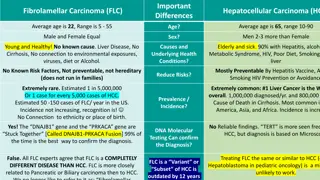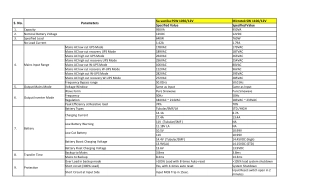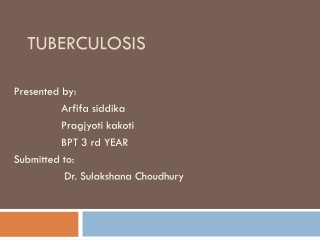Understanding Malignant Melanoma: Types, Signs, and Prognosis
Malignant melanoma is a serious skin cancer with various types, including superficial spreading, nodular, acral lentiginous, lentigo maligna, and amelanotic. Recognizing early signs such as ABCDEF (Asymmetry, Borders, Colour, Diameter, Evolving, Funny-looking) is crucial for prompt diagnosis. Macroscopic features like changes in size, shape, color, and thickness can indicate malignancy. Genetic and acquired risk factors contribute to its rising incidence, with Breslow thickness being a key prognostic factor. Sentinel node biopsy aids staging. Stay vigilant for skin changes and seek medical attention promptly.
Download Presentation
Please find below an Image/Link to download the presentation.
The content on the website is provided AS IS for your information and personal use only. It may not be sold, licensed, or shared on other websites without obtaining consent from the author. Download presentation by click this link. If you encounter any issues during the download, it is possible that the publisher has removed the file from their server.
Presentation Transcript
Clinical Case Scenario Naseralla J Elsaadi Consultant General Surgeon Clinical Surgery In General BMC, Benghazi
Malignant melanoma A 35 year-old woman presents with a long standing history of a skin pigmented lesion in her lower leg. However, recently she has noticed this to be larger and growing in size. The lesion is itchy and has bled from the surface a few times.
Questions Questions: 1- What are the different types of malignant melanoma?
Several types of malignant melanomas are recognized as follows: Superficial spreading melanoma Superficial spreading melanoma. Superficial spreading melanoma is the most common type of melanoma. ... Nodular melanoma Nodular melanoma. ... Acral Acral- -lentiginous melanoma lentiginous melanoma. ... Lentigo maligna melanoma Lentigo maligna melanoma. ... Amelanotic and desmoplastic melanomas Amelanotic and desmoplastic melanomas.
Macroscopic features in naevi suggestive of Malignant Melanoma Change in size Shape Colour Thickness (elevation/nodularity or ulceration) Satellite lesions (pigment spreading into surrounding area) Tingling/itching /serosanguinous discharge (usually late signs)
Early signs of melanoma are summarized by the mnemonic "ABCDEF": A Asymmetry B Borders (irregular with edges and corners) C Colour (variegated) D Diameter (greater than 6 mm (0.24 in) E Evolving over time F Funny looking
Malignant melanoma Rising incidence Genetic and acquired risk factors Superficial spreading form the most common Breslow thickness most important prognostic indicator Sentinel node biopsy useful for staging
Questions Questions: 2- What is Breslow s thickness?
Breslows thickness is use for assessing the prognosis of a malignant melanoma Breslow s thickness is the measurement of the depth of the melanoma from the surface of the skin down through to the deepest point of the tumour. It's measured in millimetres (mm) with a small ruler, called a micrometer.
Primary melanoma on the arm of a woman aged 35 years. The arrow indicates the Breslow thickness. This is defined as the microscopically measured vertical depth of invasion of the tumour from the granular layer of the epidermis to its deepest part within the dermis or subcutaneous tissue
Questions Questions: 3- How is malignant melanoma treated?
Treatment of malignant melanoma depends on clinical stage. Thinner melanomas may only require surgery to remove the cancer and some normal tissue around it. If the melanoma is thicker, doctor may recommend additional tests to see if the cancer has spread before determining your treatment options.
Treatment of malignant melanoma depends on clinical stage. The current guidelines for excision are: The current guidelines for excision are: - In Situ melanoma : 0.5 cm margins excision - Breslow s Thickness up to 1 mm : 1 cm margins excision - Breslow s Thickness more than 1 mm : 2 cm margins excision
Treatment of malignant melanoma depends on clinical stage. If there's a risk that the cancer has spread to the lymph nodes, your doctor may recommend a procedure known as a sentinel node biopsy. node biopsy. sentinel
Melanoma metastasis in a sentinel lymph node: Melanoma metastasis in a sentinel lymph node: A) The large melanoma cells are present in a background of numerous small lymphocytes (haematoxylin and eosin stain haematoxylin and eosin stain) B) The melanoma cells are more easily identified with an S S- -100 immunohistochemical stain immunohistochemical stain 100 protein protein
Treatment of malignant melanoma depends on clinical stage. For people with more-advanced melanomas, doctors may recommend imaging tests to look for signs that the cancer has spread to other areas of the body. Imaging tests may include X-rays, CT scans and positron emission tomography (PET) scan
Questions Questions: 4- When would you use a skin graft in the treatment of malignant melanoma?
If the defect following excision of the melanoma is too large for skin apposition, and healing by secondary intention is inappropriate, skin graft can be used. Free Skin Graft, both Split (PTSG) or Full thickness (FTSG), taken from another part of the body, rely on revascularization from a healthy, well vascularized wound bed.
Key points: Key points: Excision biopsy with 2 mm margins is appropriate whenever possible. Wide excision can then be based on the Breslow thickness. Tumors >1 mm thick may benefit from SLN biopsy. SLN biopsy provides accurate prognostic information. Staging investigations are not indicated unless metastasis is evident. Careful follow up is important to detect new melanomas and disease recurrence.

















































